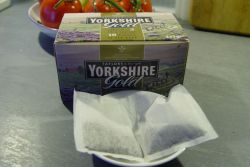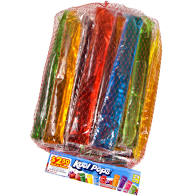Makeh BePatish: Difference between revisions
From Halachipedia
| Line 9: | Line 9: | ||
==Practical Examples== | ==Practical Examples== | ||
[[Image:Tea-bags.jpg|250px|right]] | |||
[[Image:Ice pops.jpg|250px|right]] | |||
#It is forbidden to separate tea packets that are slightly connected.<ref>Menuchat Ahava 3:16:14 holds that it is forbidden to separate tea packets since it is makeh bpatish. Halacha Sheleimah 2:20 isn't concerned for makeh bpatish since the tea bags were completed and functional even before being separated. However, he says that it is koreah to separate them and one could do it with a shinui.</ref> | |||
# Some say that it is permitted to separate ice popsicles that are connected with a shinui such as tearing them with one's teeth.<Ref>Halacha Sheleimah 2:20 compares separate ice pops sticks to the question of separating yogurts but doesn't address the ice pops in his conclusion. Dor Hamelaktim v. 5 p. 3011 quotes Hilchot Shabbat BShabbat 1:14:38 who forbids separating the Igloo pops because of makeh bpatish and the Minchat Ish 17:11 and Shabbat Hashabbat 14:8 who are lenient. They think that it isn't makeh batish or mechataich since the plastic wrappers aren't a bona fide utensil, it is merely a minimal covering of food. Also, one doesn't care that it is cut in a straight line so it isn't mechataich.</ref> | |||
# Some interesting examples of Makeh BiPatish include bending a pair of eyeglasses back into shape, pulling apart two connected plastic utensils left uncut by the factory, putting new shoelaces into shoes, and fashioning a hook from a wire hanger.<ref> Rav Dovid Ribiat (v. 4, p. 1111-6) </ref> | # Some interesting examples of Makeh BiPatish include bending a pair of eyeglasses back into shape, pulling apart two connected plastic utensils left uncut by the factory, putting new shoelaces into shoes, and fashioning a hook from a wire hanger.<ref> Rav Dovid Ribiat (v. 4, p. 1111-6) </ref> | ||
# Some typical exemptions from Makeh BiPatish are ''derech'' ''tashmisho'' (using things in the way that they are commonly used; adjusting an object as part of its regular mode of use cannot be seen as creating a new object), restoring an item that has not become unusable and lost its original identity, and an improvement that is clearly only temporary.<ref> Rav Dovid Ribiat (v. 4, p. 1131) </ref> | # Some typical exemptions from Makeh BiPatish are ''derech'' ''tashmisho'' (using things in the way that they are commonly used; adjusting an object as part of its regular mode of use cannot be seen as creating a new object), restoring an item that has not become unusable and lost its original identity, and an improvement that is clearly only temporary.<ref> Rav Dovid Ribiat (v. 4, p. 1131) </ref> | ||
==Gezerot Dirabanan== | ==Gezerot Dirabanan== | ||
Revision as of 20:51, 13 December 2020
| This article is okay. |
Definition
- According to most Rishonim, the Av Melacha of Makeh BiPatish is violated when doing the finishing act on a keili. [1]
- More generally, the ideas of Makeh BiPatish are creating something useful and perfecting a keili[2]. Therefore, according to some rishonim, Makeh BiPatish is limited to keilim on which no other melacha was done before, or the final act after other melachos were done before.[3]
- An act that is irreversible may also be Makeh BiPatish, even before the keili is finished.[4]
- Also, finishing something may not be considered Makeh BiPatish if it involves a process, not just a single direct act.[5]
- Additionally, it might only be the Av melacha of Makeh BiPatish if the tikun would be a recognizable improvement and not just a tikun from a halachic perspective. For example, purifying a keili that is tameh is not the Av because the purification is only a halachic tikun.[6]
- Finally, a loosely assembled keili that came apart can be reassembled, as long as it’s not considered broken in its disassembled state, as nothing new is being created.[7]
Practical Examples
- It is forbidden to separate tea packets that are slightly connected.[8]
- Some say that it is permitted to separate ice popsicles that are connected with a shinui such as tearing them with one's teeth.[9]
- Some interesting examples of Makeh BiPatish include bending a pair of eyeglasses back into shape, pulling apart two connected plastic utensils left uncut by the factory, putting new shoelaces into shoes, and fashioning a hook from a wire hanger.[10]
- Some typical exemptions from Makeh BiPatish are derech tashmisho (using things in the way that they are commonly used; adjusting an object as part of its regular mode of use cannot be seen as creating a new object), restoring an item that has not become unusable and lost its original identity, and an improvement that is clearly only temporary.[11]
Gezerot Dirabanan
- Some gzeiros Dirabanan include playing musical instruments (lest they break and you fix them), clapping or dancing (lest you come to play and break musical instruments), and toveling keilim (because it makes them permitted to use).[12]
Links
- Hilchot Shabbat Makeh bPatish by Rabbi Assaf Bednarsh
- The Final Hammer Blow- Makeh Bipatish by Rabbi Mordechai Rhine
Sources
- ↑ Rav Eliyahu Baruch Shulman Shiurim on Shabbos, August-October, 2014 on YUTorah.org. explains that Rashi Shabbos 102b s.v. mipnei shehu k’misaken melacha, Shabbos 73a s.v. makeh bipatish, Shabbos 47a s.v.chayav chatas defines this as the act which shows that the keili is done, and Tosfos Shabbos 102b s.v. makeh bipatish say that this is the last act on the keili itself. According to the Rambam Shabbos 10:16, however, that is a Toldah of Makeh BiPatish; the Av is doing any Maase Uman, which is a professional act. See Rav Issur Zalman Meltzer (Even HaEzel Shabbos 10:16)
- ↑ See Rav Dovid Ribiat (v. 4, p. 1112), Rav Eliyahu Baruch Shulman Shiurim on Shabbos, August-October, 2014 on YUTorah.org.
- ↑ See Yireiim (quoted in Hagahos Shenimtziu b’Mordechai, perek haBoneh), Mirkeves Hamishnah (Shabbos 10:14), Kehilas Yaakov (Mahadura Chadasha, Shabbos 41), and Gra (Shnos Eliyahu Shabbos 12:1 s.v. Hakodeach kol shehu chayav) for a more complete discussion of the issues.
- ↑ See Igros Moshe 1:122:2
- ↑ See Rashi as explained by Rav Dovid Ribiat (v. 4, p. 1121, note 30a), Rav Eliyahu Baruch Shulman Shiurim on Shabbos, August-October, 2014 on YUTorah.org.
- ↑ See Minchas Chinuch (32:27)
- ↑ See Rav Dovid Ribiat (v.4, p. 1127-8)
- ↑ Menuchat Ahava 3:16:14 holds that it is forbidden to separate tea packets since it is makeh bpatish. Halacha Sheleimah 2:20 isn't concerned for makeh bpatish since the tea bags were completed and functional even before being separated. However, he says that it is koreah to separate them and one could do it with a shinui.
- ↑ Halacha Sheleimah 2:20 compares separate ice pops sticks to the question of separating yogurts but doesn't address the ice pops in his conclusion. Dor Hamelaktim v. 5 p. 3011 quotes Hilchot Shabbat BShabbat 1:14:38 who forbids separating the Igloo pops because of makeh bpatish and the Minchat Ish 17:11 and Shabbat Hashabbat 14:8 who are lenient. They think that it isn't makeh batish or mechataich since the plastic wrappers aren't a bona fide utensil, it is merely a minimal covering of food. Also, one doesn't care that it is cut in a straight line so it isn't mechataich.
- ↑ Rav Dovid Ribiat (v. 4, p. 1111-6)
- ↑ Rav Dovid Ribiat (v. 4, p. 1131)
- ↑ Rav Dovid Ribiat (v. 4, p. 1159-62)

